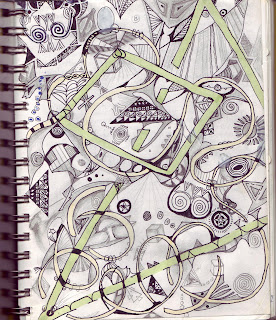I first encountered Kenneth Lumpkin on Twitter, through the
hashtag #WritingCommunity. He posted a few poems of his that I found simple,
elegant, direct, and beautiful in the tradition of William Carlos Williams. After
a few friendly interactions, I asked him to recommend one of his books, as I
had finally come into some extracurricular fiduciary spice (money), he
recommended his most recent. But when I browsed his Amazon author page, I found
he had written a book called “Song of Ramapough: A Poetics of Place.” My
antennae bristled.
I wrote my PhD dissertation on the ideological representations
of white trash in different cultural products including literature, photography,
film, television, fashion, and journalism, in high culture and popular culture.
This is an eggheady way of saying I explored how the social categories of race
and class interact in the meanings made by these representations. For the reason
of ever-disappearing horizons of space and time, I had to cut a few of my
planned chapters, one of which was an analysis of the film Out of the
Furnace, starring Christian Bale, Woody Harrelson and Casey Affleck, which
featured a controversial representation of the Ramapough Mountain People, who
sued the filmmakers. They are portrayed in the film as brutal meth-addled outlaws.
In fact, the history of the Ramapough Mountain People is
fascinating. They are what is known as a tri-racial isolate community. What
that means is that in the early colonial history of America, runaway and freed
slaves often intermarried with poor whites (sometimes newly released indentured
labourers) and Indigenous people driven to remote areas by the process of
colonization. While the Bureau of Indian Affairs of the US does not officially recognize
the Ramapough Mountain Indians as a federal tribe, the state of New Jersey did
recognize them as a tribe descended from the Lenape Delaware, an Algonquin
speaking Indigenous group. The Ramapough Mountains consist of a few ridges and valleys
on the border of New Jersey and New York, about 40 km from New York City.
Needless to say, I had to buy the book. In the foreword,
Kenneth discusses how writing the book was inspired by the place-centred poetry
of William Carlos Williams’ brilliant book Paterson and the Maximus poems
of Charles Olsen. The foreword, written by Flavia Alaya draws the same
comparisons, although my opinion of Lumpkin’s work differs from hers. While she
sees more Olsen in Lumpkin, I see an absence of the endearing confusion of
Olsen’s poetry, and more the crystalline clarity of Williams’ verse. Lumpkin
figures that through a poetic exploration of place, through lenses such as
geology, history, and high Romantic wanderings through the wilds of the
mountains, he might better come to know the earth itself, a mission I
wholeheartedly endorse and aspire to myself. After all, the book is published
by Hug the Earth Publishing.
I was eager to read and savour this one because Paterson
is my favourite book-length poem aside from Byron’s Don Juan (which I
must admit I haven’t read all the way through yet – some day), Shakespeare’s
plays, and Anne Carson’s The Autobiography of Red. In it, Williams
polished a uniquely polyvocal and American idiom. Song of Ramapough
hews closely to these influences, but one can also detect the influence of the
encyclopedic-style chapters of Melville’s masterpiece Moby Dick,
especially in the parts near the end that rather factually guide the reader
through the geological composition and history of the place.
While there are some moments that gave me pause, such as
when he discusses the Haudensaunee (the Indigenous group that includes the Six
Nations of the Confederacy, whose political structure influenced the United
States’ own) stripping all political authority of the women. This contradicts
the important role that women played in the politics of the Haudensaunee as
caretakers of not only children and the home, but of the land itself. It is
possible that Lumpkin is referring to Haudensaunee-Lenape relations that I’m
ignorant of, however. There are charming moments in the book, alternating a
newspaper’s account of a robbery of a woman homesteader in the area in 1790
with the first buzzing of a yellow jacket experienced by the poet on the next
page.
I particularly loved poem 6, which I will reproduce here in
full to discuss:
No more
a mountain
stronghold
or fortress
around
me, but lighted
oak is my
home
flames
whisper the dying
secret
of the wood,
forgotten
grandfathers
are my
company
teaching
me the songs
of the
wind, warming the Earth
while
speaking the oldest
of
languages.
The
bracing enjambement of this poem draws the reader along its thread, and the
line break between the first and second stanza really teases out the doubled
meaning of “lighted/oak is my home.” One thinks of a wooded mountain side in
the tradition of Wordsworth’s “Tintern Abbey” being pierced by straight-lined
shafts of evening light. However, the second stanza transforms the “lighted”
wood from dappled sunlight to campfire burning. Alternating all the historical
data of the book with a phrase like “forgotten grandfathers are my company”
really lends the next lines some gravitas in the spirit of receiving
wisdom from ancestors. The oldest of languages is of course the interpretation
of the earth itself, its animal trails, its grumbles, its tree rings, its soil,
where to find water and food, etc.
Kenneth
Lumpkin now lives in London, Ontario. I highly recommend his work if you love the
poetry of the English or American Romantics such as Whitman, or if you love the
work of Olsen and especially Williams. His latest book, available on Amazon, is
Possum: Tales of the Wood. He has a total of five books available for
sale there. Here is a link: Amazon.ca
: Kenneth Lumpkin













